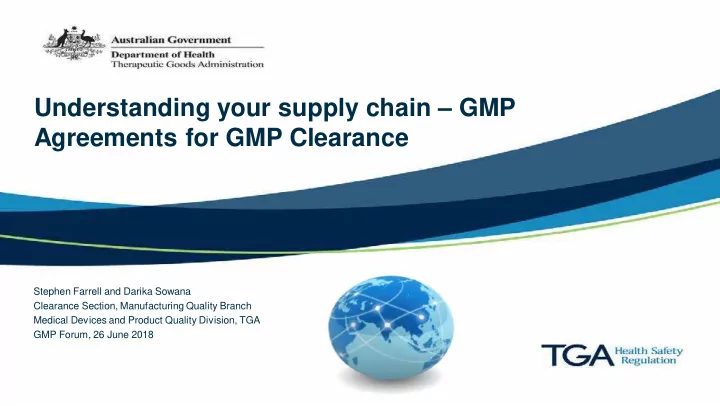

Understanding your supply chain – GMP Agreements for GMP Clearance Stephen Farrell and Darika Sowana Clearance Section, Manufacturing Quality Branch Medical Devices and Product Quality Division, TGA GMP Forum, 26 June 2018
Agenda • Evolution of the modern supply chain • Example of a typical global supply chain • Additional entities • GMP agreement requirements • Key points during GMP clearance assessment 1
Evolution of the modern supply chain • Pharmaceutical supply chains have become increasingly complex over the past number of years • Historically a single manufacturing facility would be more likely to perform every step of manufacture of a product • Sectors of industry have shifted towards Contract Manufacturing Organisations (CMO) performing a specific or limited number of processes but on a large scale basis 2
Evolution of the modern supply chain • This has resulted in multiple manufacturing sites involved in the manufacture of a single product • The drivers behind this shift can range from production costs to manufacturing expertise • Increased focus on manufacturers supply chain during GMP inspections • Increase in the number of manufacturers required to entered on the ARTG 3
Typical supply chain 4
Additional entities Example: Australian sponsor importing medicine through a separate Distributor or Intermediary located within Australia or overseas 5
Additional entities Example: Australian sponsor importing medicine through another Australian sponsor i.e. Generics, Additional trade names 6
Additional entities Example: Australian sponsor liaises through subsidiary or parent company located overseas and has no direct relationship with manufacturer 7
GMP agreement requirements Why we require it GMP, quality or technical agreements are required because they provide: • information about the roles and responsibilities of each party in relation to the critical aspects of GMP • any specific technical aspects related to the product’s manufacture • further information as to the roles and responsibilities of the Australian Marketing Authorisation (MA) holder in relation to post market surveillance obligations. 8
GMP agreement requirements What you should provide Provide the signed GMP, quality or technical agreement relevant to the scope of your application. Ensure that it: • meets the full requirements of chapter 7 of the PIC/S guide to good manufacturing practice for medicinal products – Part I. 9
GMP agreement requirements Take particular care Ensure that the GMP, quality or technical agreement: • clearly identifies the products and steps of manufacture (activities) relevant to the scope of your GMP clearance application • clearly describes the role of each party subject to the agreement • has been signed by all parties to the agreement. 10
GMP agreement requirements Alternative evidence Depending your scope and/or relationship with the manufacturer, you may provide the: • signed GMP, quality or technical agreement between the principal manufacturer and its subcontractor – E.g. contract laboratories, sterilisers etc. 11
GMP agreement requirements Alternative evidence • equivalent signed documentation that clearly outlines the roles and responsibilities of the Australian MA holder (Sponsor) and the other entities in the supply chain. – E.g. for subsidiaries of the same parent company 12
Key points during GMP Clearance assessment • The GMP agreement is current and is not outside the review period typically applied to GMP documentation • The parties to the agreement are clearly listed and have signed the agreement • There is a clear and unambiguous breakdown of which entity is responsible for critical aspects of the agreement 13
Key points during GMP Clearance assessment • Any ambiguity in the responsibilities is adequately explained in the agreement • Terminology used is relevant for the Australian market (i.e. release for supply) • Australian Sponsor meets the requirements of PIC/S clause 1.11 for PQR input and review • Oversight of the shipping of the product to Australia between the parties in the agreement are clearly documented including provisions for temperature excursions and investigations 14
Key points during GMP Clearance assessment • Post market responsibilities of the Australian sponsor are clearly outlined (i.e. recalls, complaints) including the flow of information between the relevant parties • The agreement must cover the dosage forms applicable to the GMP clearance • There should be a provision that the sponsor will provide the manufacturer with marketing authorisation requirements for Australia • Provision for sponsor approval of product labels 15
Questions? 16
Recommend
More recommend